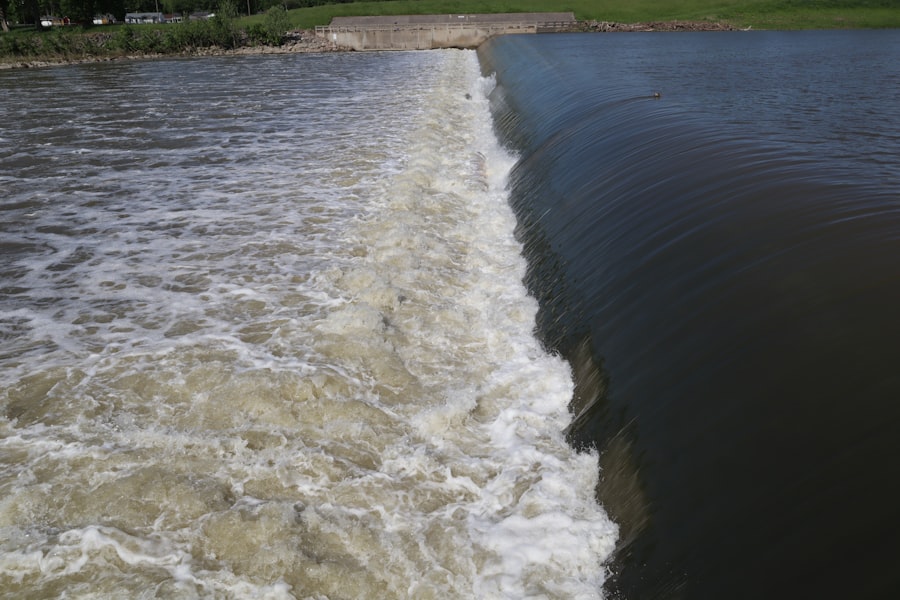Managing water utility debt is a critical aspect of ensuring the long-term sustainability and efficiency of water services. As a consumer or stakeholder, you may not always be aware of the financial intricacies that underpin your local water utility, but understanding these dynamics is essential. Water utilities often rely on debt to finance infrastructure projects, upgrade aging systems, and maintain service quality.
However, if not managed properly, this debt can spiral out of control, leading to increased rates for consumers and diminished service quality. Effective debt management is not just about keeping the books balanced; it’s about ensuring that the utility can continue to provide reliable services to the community. When debt levels are high, utilities may struggle to invest in necessary upgrades or expansions, which can lead to service disruptions and public dissatisfaction.
As a consumer, you have a vested interest in how your water utility manages its finances, as it directly impacts the quality and reliability of the water services you receive. Check out this video on how investors making money from water.
Key Takeaways
- Managing water utility debt is crucial for long-term financial stability
- Debt can impact water utility operations and infrastructure investment
- Effective debt management strategies are essential for sustainable financial health
- Balancing debt repayment with infrastructure investment is a key challenge for water utilities
- Dividends play a significant role in water utility financial management and require careful consideration
Understanding the Impact of Debt on Water Utility Operations
The impact of debt on water utility operations is multifaceted and can significantly influence both short-term and long-term performance. When a utility takes on debt, it must allocate a portion of its revenue to service that debt, which can limit its ability to invest in other critical areas. This can lead to a cycle where the utility is forced to raise rates to cover debt payments, further straining the financial situation for consumers like you.
Understanding this cycle is crucial for recognizing how financial decisions made by water utilities can affect your monthly bills. Moreover, high levels of debt can hinder a utility’s ability to respond to emergencies or unexpected challenges. For instance, if a major infrastructure failure occurs, a heavily indebted utility may lack the financial flexibility to address the issue promptly.
This can result in prolonged service outages or degraded water quality, both of which can have serious implications for public health and safety. As a stakeholder, being aware of these potential risks can help you advocate for better financial practices within your local water utility.
Strategies for Effective Debt Management in Water Utilities

To navigate the complexities of debt management effectively, water utilities can adopt several strategies that promote financial health and operational efficiency. One key approach is to develop a comprehensive financial plan that includes clear guidelines for borrowing and repayment. This plan should take into account projected revenues, necessary capital expenditures, and potential risks associated with fluctuating interest rates or economic downturns.
Another effective strategy involves diversifying funding sources. Relying solely on traditional debt instruments can be risky, especially in volatile economic conditions.
Water utilities can explore alternative financing options such as public-private partnerships or grants from government agencies. These alternatives not only reduce reliance on debt but also provide opportunities for innovation and collaboration that can enhance service delivery.
Balancing Debt Repayment with Infrastructure Investment
| Year | Debt Repayment | Infrastructure Investment |
|---|---|---|
| 2018 | 500 million | 700 million |
| 2019 | 550 million | 750 million |
| 2020 | 600 million | 800 million |
Balancing debt repayment with infrastructure investment is one of the most challenging aspects of managing a water utility’s finances. On one hand, utilities must prioritize paying off existing debts to maintain their creditworthiness and avoid defaulting on loans. On the other hand, they must also invest in infrastructure improvements to ensure reliable service delivery and compliance with regulatory standards.
This delicate balance requires careful planning and prioritization. One effective way to achieve this balance is through a phased approach to infrastructure investment. By identifying critical projects that require immediate attention and deferring less urgent upgrades, utilities can manage cash flow more effectively while still addressing pressing needs.
Additionally, implementing asset management practices can help utilities prioritize investments based on condition assessments and risk evaluations. As a consumer, understanding how your local utility prioritizes these investments can provide insight into their long-term planning and commitment to maintaining high service standards.
The Role of Dividends in Water Utility Financial Management
Dividends play a significant role in the financial management of water utilities, particularly those structured as public or private entities. For publicly traded utilities, dividends represent a return on investment for shareholders and are often seen as an indicator of financial health. However, for municipal utilities, the concept of dividends may manifest differently, focusing more on reinvestment into the community rather than direct financial returns to investors.
In both cases, the distribution of dividends must be carefully considered in relation to overall financial stability. If a utility prioritizes dividend payments over necessary infrastructure investments or debt repayment, it risks jeopardizing its long-term viability. As a stakeholder, it’s important to recognize how dividend policies can impact the utility’s ability to maintain service quality and invest in future growth.
Ensuring Sustainable Dividend Distribution in Water Utilities

To ensure sustainable dividend distribution, water utilities must adopt policies that align with their financial health and operational needs. This involves establishing clear criteria for when and how dividends are distributed, taking into account factors such as cash flow, capital requirements, and debt obligations. By implementing a disciplined approach to dividend distribution, utilities can avoid overextending themselves financially while still providing value to stakeholders.
Moreover, transparency in dividend policies is crucial for building trust with consumers and investors alike. When stakeholders understand how dividend decisions are made and how they relate to the utility’s overall financial strategy, they are more likely to support those decisions. As a consumer, advocating for transparency in dividend distribution can help ensure that your local utility remains accountable and focused on long-term sustainability.
Regulatory Considerations for Water Utility Dividends
Regulatory considerations play a vital role in shaping how water utilities manage dividends and overall financial practices. Regulatory bodies often impose guidelines regarding rate-setting, capital investment requirements, and financial reporting standards that directly impact dividend policies. Understanding these regulations is essential for both utilities and consumers who wish to engage in informed discussions about financial management practices.
Additionally, regulatory frameworks may vary significantly between regions or types of utilities, which can complicate the landscape for dividend distribution. For instance, municipal utilities may face different constraints compared to investor-owned utilities regarding how profits are allocated. As a stakeholder, staying informed about regulatory changes can empower you to advocate for policies that promote responsible financial management within your local water utility.
The Relationship Between Debt and Dividends in Water Utilities
The relationship between debt and dividends in water utilities is complex and often interdependent. High levels of debt can limit a utility’s ability to pay dividends, as funds must first be allocated toward servicing that debt. Conversely, consistent dividend payments may signal financial stability but could also divert funds away from essential investments or debt repayment obligations.
Understanding this relationship is crucial for stakeholders who wish to assess the overall health of their local water utility. A utility that maintains a balanced approach—prioritizing both responsible debt management and sustainable dividend distribution—will likely be better positioned for long-term success. As a consumer or investor, being aware of how these factors interact can help you make informed decisions regarding your engagement with the utility.
Case Studies of Successful Debt and Dividend Management in Water Utilities
Examining case studies of successful debt and dividend management in water utilities can provide valuable insights into best practices and innovative strategies. For instance, some utilities have implemented robust financial planning processes that incorporate scenario analysis to anticipate potential challenges related to debt servicing or dividend distribution. These proactive measures have allowed them to navigate economic fluctuations while maintaining service quality.
Another noteworthy example involves utilities that have embraced technology to enhance operational efficiency and reduce costs. By investing in smart metering systems or advanced data analytics, these utilities have been able to optimize their operations, leading to improved cash flow and greater flexibility in managing both debt and dividends. As a stakeholder, learning from these success stories can inspire advocacy for similar initiatives within your local water utility.
Risks and Challenges Associated with Water Utility Debt and Dividends
Despite the potential benefits of effective debt and dividend management, several risks and challenges persist within the realm of water utilities. Economic downturns or unexpected events—such as natural disasters—can strain financial resources and complicate debt repayment efforts. Additionally, regulatory changes may impose new requirements that impact how utilities manage their finances.
Moreover, public perception plays a significant role in shaping the decisions made by water utilities regarding debt and dividends. If consumers perceive that their utility is prioritizing dividends over service quality or infrastructure investment, it could lead to public backlash and decreased trust in the utility’s management. As a stakeholder, being aware of these risks can help you engage constructively with your local utility while advocating for responsible financial practices.
Best Practices for Long-Term Financial Stability in Water Utilities
To achieve long-term financial stability, water utilities should adopt best practices that encompass both effective debt management and sustainable dividend distribution. One key practice involves establishing clear financial policies that outline guidelines for borrowing, repayment schedules, and dividend distribution criteria. These policies should be regularly reviewed and updated based on changing economic conditions or regulatory requirements.
Additionally, fostering strong relationships with stakeholders—including consumers, investors, and regulatory bodies—can enhance transparency and accountability within the utility’s operations. Engaging stakeholders in discussions about financial strategies can lead to greater understanding and support for necessary decisions related to debt and dividends. As a consumer or stakeholder, advocating for these best practices can contribute to the overall health and sustainability of your local water utility.
In conclusion, managing water utility debt effectively is essential for ensuring reliable service delivery while balancing the need for infrastructure investment and sustainable dividend distribution. By understanding the complexities involved in these financial dynamics, you can play an active role in advocating for responsible practices within your local water utility—ultimately contributing to its long-term success and stability.
Water utility debt and dividends are critical topics in the financial management of public utilities, as they directly impact the sustainability and service quality of water supply systems. For a deeper understanding of how these financial elements interact, you can read more in this related article on the subject. Check it out here: Water Utility Debt and Dividends.
WATCH THIS! Why Wall Street Is Exploding Your Water Bill
FAQs
What is water utility debt?
Water utility debt refers to the money that a water utility company borrows in order to finance its operations, infrastructure improvements, and other capital projects. This debt is typically issued in the form of bonds and is repaid over time with interest.
How do water utility companies use debt?
Water utility companies use debt to fund various capital projects, such as building or upgrading water treatment plants, replacing aging infrastructure, and expanding their water distribution systems. By using debt, these companies can make these necessary investments without having to rely solely on rate increases or government funding.
What are dividends in the context of water utility companies?
Dividends are payments made by a water utility company to its shareholders out of its profits. These payments are typically made on a regular basis, such as quarterly or annually, and are a way for the company to distribute its earnings to its investors.
How are water utility dividends related to debt?
Water utility companies must carefully manage their debt levels in order to maintain financial stability and creditworthiness. This means balancing the need for debt to fund capital projects with the ability to generate enough cash flow to cover debt payments and still have funds available for dividends.
What are the potential risks of water utility debt and dividends?
High levels of debt can increase the financial risk for water utility companies, as they may struggle to make debt payments if their cash flow is insufficient. Similarly, paying out dividends when the company is heavily indebted can further strain its financial resources and impact its ability to invest in necessary infrastructure improvements.
